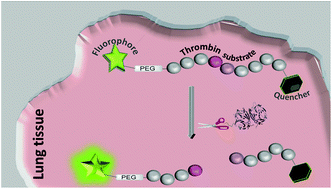Highly selective and rapidly activatable fluorogenic Thrombin sensors and application in human lung tissue†
Abstract
A library of FRET-based peptides were prepared and studied as Thrombin substrates. This identified probes that showed selective activation by Thrombin, low fluorescent background signals, stability to Factor Xa, matrix metalloproteases, and primary human inflammatory cell lysates and supernatant. These were selected for further optimization, creating a second generation of fluorogenic probes with improved solubility and Plasmin resistance. The optimised probe allowed the detection of Thrombin activity in ex vivo fibrotic human tissue.



 Please wait while we load your content...
Please wait while we load your content...